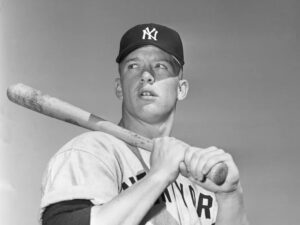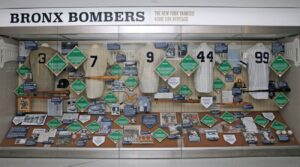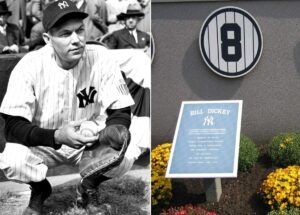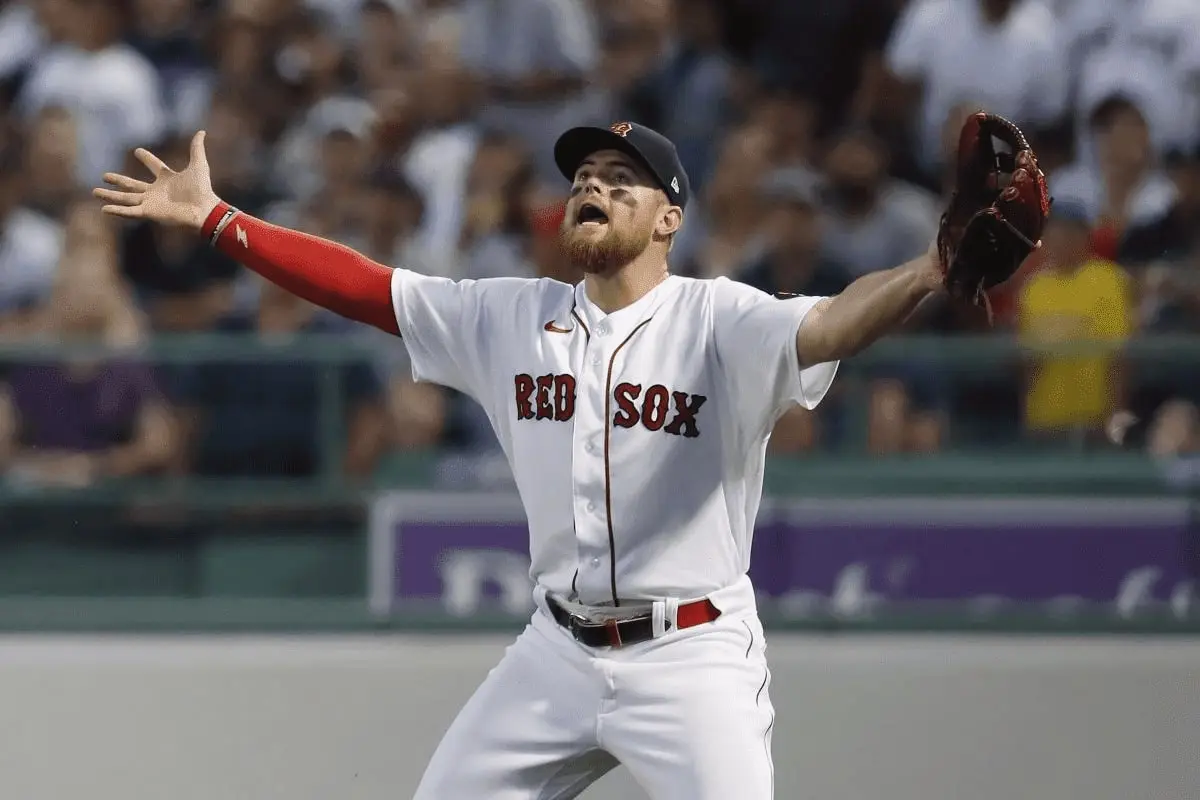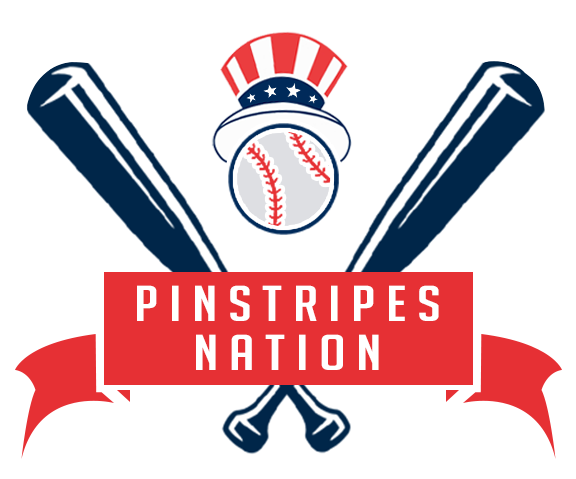Top 5 Catchers in Yankees History

Joe Najarian
More Stories By Joe Najarian
- Mother’s Day: How Anthony Volpe’s mom molded him into a Yankee phenom
- 470-Foot Bomb: Aaron Judge sets career record despite Yankees’ loss to Red Sox
- Giancarlo Stanton to rejoin Yankees for Phillies series opener on Monday
- Yankees’ top prospect Jasson Dominguez nears return after oblique injury
- Rich Hill draws Yankees’ attention for midseason signing
- March 11, 2024
- 7:13 am
- No Comments
Table of Contents
The New York Yankees have been blessed to have an outstanding crop of catchers throughout their history.
The team has employed both defense-first catchers, such as Joe Girardi and Kyle Higashioka, and offensively productive catchers like Gary Sanchez and Jorge Posada. This coming season, the Yankees have a versatile catching tandem in Jose Trevino and rookie Austin Wells; Trevino won the Platinum Glove in 2022 for his outstanding defense, while Wells is continually improving his own defense while boasting a highly-regarded bat.
But who are the truly best catchers in the Yankees’ history? It is rather easy to name a top five, as the Yankees have retired the numbers of exactly five catchers. But outside of number one, ranking the other four is pretty difficult.
Unlike future rankings, both individual and team success will contribute to these rankings; as mentioned earlier, having a great catcher is crucial to team success.
#5. Elston Howard (1955-1967): Yankees’ first black hero
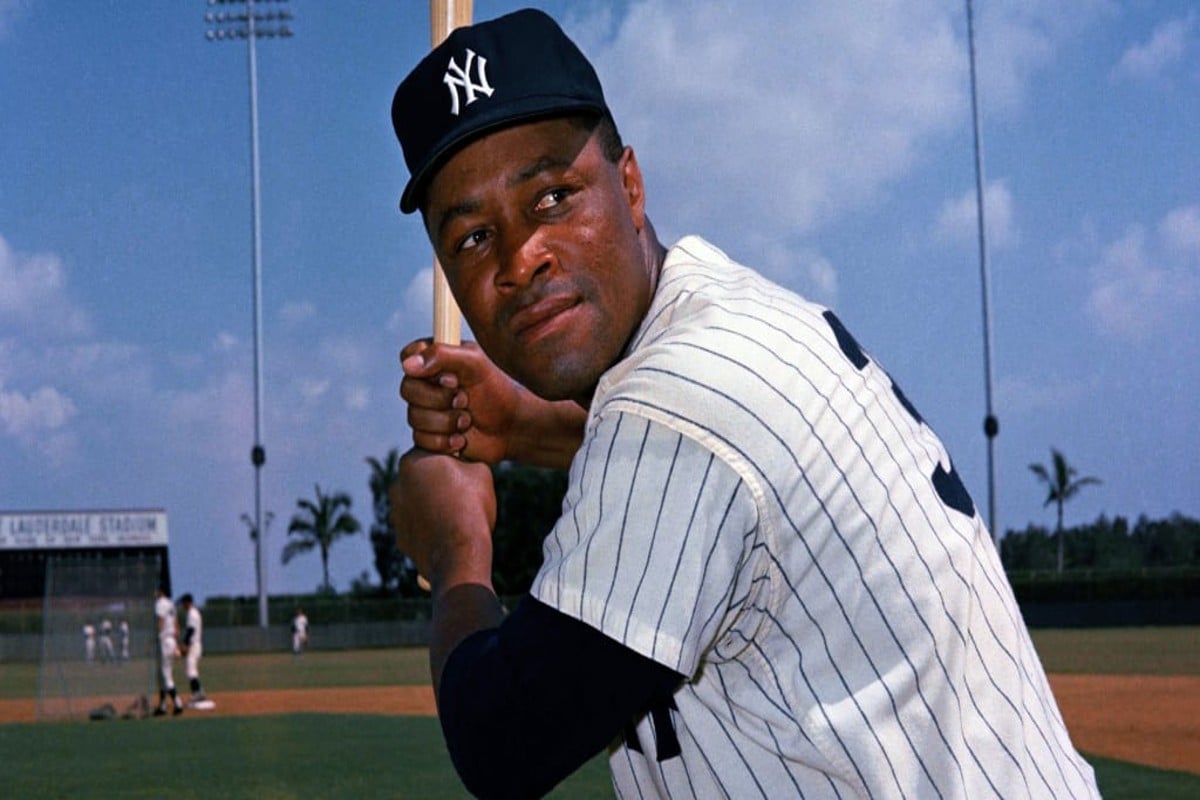
Elston Howard is widely known for being the first African-American player in Yankees history, but that is unfair to him because he was much more than that.
Faced with the Herculean task of succeeding Yogi Berra behind the plate, Howard filled the role tremendously and was an integral part of the Yankees’ success in the early 1960s. He would spend almost his entire career in pinstripes, outside of the stretch run of 1967 and 1968, and totaled 31.3 fWAR thanks to a steady bat and glove.
Howard was productive in the somewhat limited playing time he had from 1955 to 1958, as manager Casey Stengel struggled to find a regular position for him to play. Nonetheless, he was named an All-Star for the first time in 1957, which would be the first of nine straight selections to the Midsummer Classic; the Yankees also played in the World Series in each of Howard’s first four seasons, which also gave him the opportunities he needed to showcase his talent. The most notable of those performances came in 1958, as he led the team back from a 3-1 series deficit against the Milwaukee Braves and received the Babe Ruth Award for Postseason MVP (although Bob Turley was named World Series MVP) for his timely hitting and defense.
It wasn’t until 1960 when Howard became the Yankees starting catcher, as Berra began playing the outfield more often. Although Howard struggled offensively that year, he showed the defensive prowess necessary to be the team’s signal caller. The next year, Howard put everything together and accrued at least 4.1 fWAR from 1961 to 1964, and had a wRC+ over 120 in three of those four seasons.
The 1961 season was a true breakout year for Howard, as he hit .348/.387/.549 with 21 home runs and a career-best .405 wOBA and 150 wRC+. 1962 saw him regress offensively with a .279/.318/.474 slash line, but he hit 21 homers again and put up a personal-best 91 RBI while improving his defense, leading the American League with a 55% caught stealing rate.
In 1963, Howard became the first African-American in American League history to win the MVP award. His offensive numbers were respectable, batting .287/.342/.528 with a career-high 28 home runs, while also driving in 85 runs, scoring 75 times, and posting a 142 wRC+. But his contributions were especially important that year, as both Mickey Mantle and Roger Maris played less than 100 games (Mantle played in just 65); as such, many of his totals were team highs. Howard also did a brilliant job handling the pitching staff, as three starters (Whitey Ford, Jim Bouton, and Al Downing) had ERAs below 2.75; coupled with his fielding ability, Howard won the Gold Glove Award and totaled 5.9 fWAR, a mark he topped the very next year (6.0 fWAR in 1964).
Overall, Howard won four World Series titles with the Yankees, hit .279/.324/.436 with 1,405 hits and 161 home runs, made 12 All-Star teams, won back-to-back Gold Gloves, and has an MVP award to his name. While he will forever be remembered as the man who broke the Yankee color barrier, Howard should also be remembered for a terrific playing career in his own right, being a more than worthy entry in Monument Park.
#4. Thurman Munson (1969-1979): Yankees most unforgettable hero
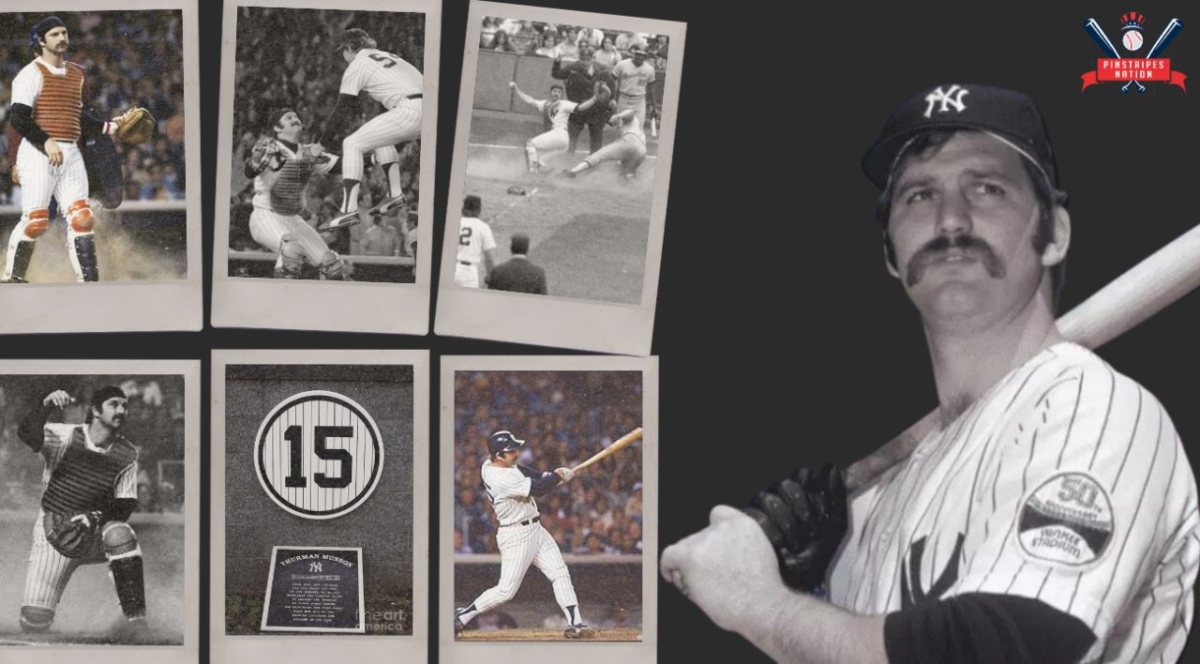
A legendary figure in Yankees history who was gone too soon, Thurman Munson was the perfect combination of talent and leadership, especially during an era of on-field and off-field conflict.
In just 11 seasons, Munson accumulated 46.1 bWAR and made seven All-Star teams, won three straight Gold Glove Awards (1973-1975), was named AL MVP in 1976, and led the Yankees to three consecutive pennants (1976-1978) and back-to-back World Series championships (1977 and 1978). During the first of those three pennant-winning seasons, Munson earned the prestigious honor of team captain, becoming the first Yankee to serve the role since Lou Gehrig’s retirement in 1939.
Munson was selected fourth overall in the 1968 MLB Draft by the Yankees, and played 26 games in 1969 before becoming the starting catcher in 1970. Although he made 97 plate appearances during his cup-of-coffee, Munson still qualified as a rookie for the 1970 season; having fully adjusted to the majors, he had one of the best rookie seasons in franchise history and won AL Rookie of the Year with 5.5 bWAR, a .302/.386/.415 slash line, a 127 wRC+, and strong defense that included a 52% caught stealing rate and 80 assists. He wasn’t an All-Star that year, but he would make the team in seven of the next nine years.
Over those nine years, Munson would become the heart and soul of the Yankees thanks to his confidence, swagger, and hard-nosed demeanor who fervently defended his team. On the field, he backed up his competitive nature with outstanding play on both sides of the ball; his strongest season was 1973, when he recorded 7.2 bWAR thanks to a .301/.362/.487 slash line, a career-high 20 home runs, 141 wRC+, .379 wOBA, and 2.1 dWAR, and his first of three straight Gold Gloves.
Munson’s hard work and leadership would be rewarded from 1976 to 1978; not only would he be named team captain before the 1976 season, but the Yankees had completed their rebuild and were now a championship contender. In his first season as captain, Munson had a 5.3 bWAR and hit .302/.337/.432 with 17 home runs and 105 RBI, and was named AL MVP thanks to leading the Yankees to the best record in the American League; they would go to the World Series, and although they were swept by the Cincinnati Reds, Munson hit .529 in the series and even had six straight hits thanks to a 4-for-4 performance in Game 4.
In 1977, Munson had his last great season as he hit .308/.351/.462 with 18 home runs and 100 RBI for a 123 wRC+; despite a season full of conflict that included a feud between Munson and new acquisition Reggie Jackson, the Yankees had their first 100-win season in 14 years and went on to win the World Series. In that Fall Classic against the Los Angeles Dodgers, Munson hit .320 with a home run and three RBI, but his biggest contributions were behind the plate; facing a Dodgers team that stole 114 bases, he caught four base stealers in six attempts to neutralize their baserunning ability. The Yankees would repeat as champs in 1978; although Munson had a down year in the regular season, he again batted .320 against the Dodgers and had seven RBI.
Sadly, the 1979 season would be Munson’s last. With his play gradually declining, he wanted to spend more time with his family in Ohio and took up flying; he tragically wouldn’t get the chance to spend that time as he was killed in a plane crash on August 2, 1979. He was only 32.
Munson’s career ended with a .292/.346/.410 lifetime average, 229 doubles, 113 home runs, and 701 RBI. Behind the plate, he caught 1,278 games, tallied 742 assists, and caught 44% of base stealers. Today, Munson is still one of the most beloved players in Yankees history, with his legacy as one of the great team leaders in sports remaining strong, and he has a case for top 3 inclusion on this list despite his career and life being cut short.
#3. Jorge Posada (1995-2011): The Core Four catcher
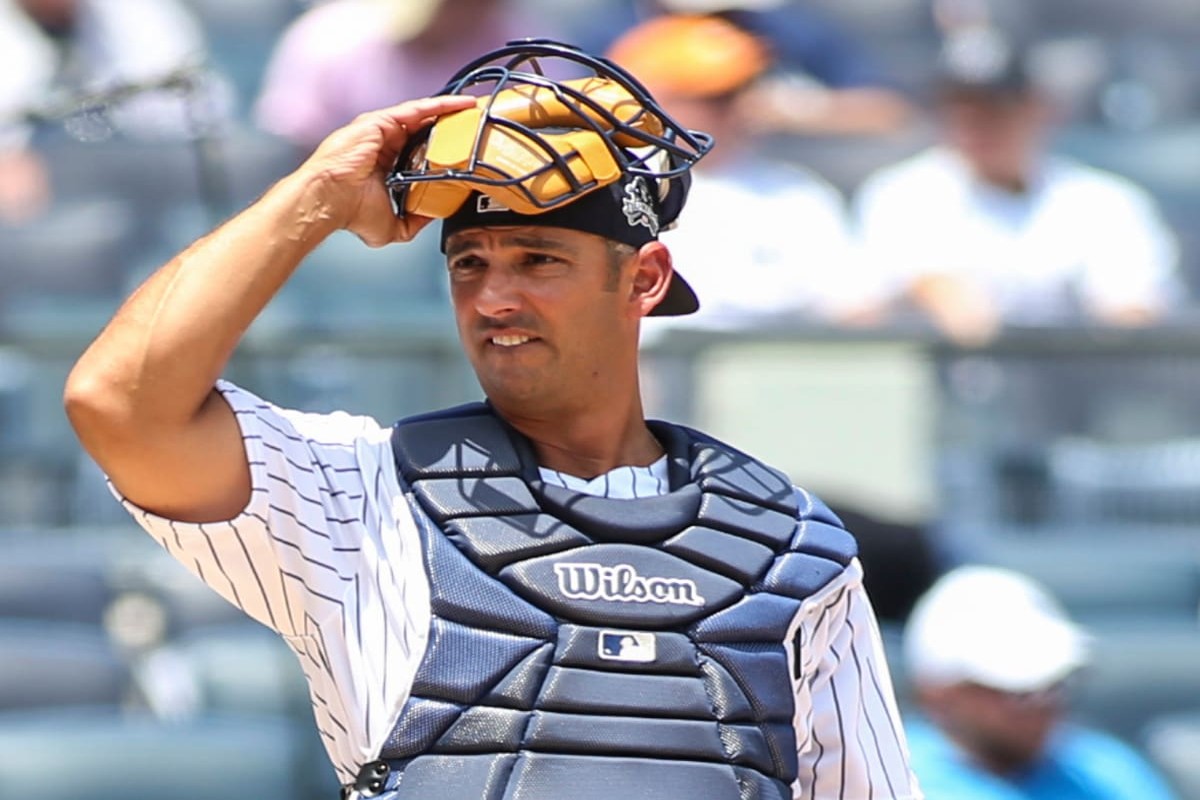
Although Jorge Posada is now considered one of the best-hitting catchers of his generation, it was a long journey towards achieving that status.
In fact, Posada didn’t even begin his baseball career as a catcher; when the Yankees drafted him as a 24th rounder in 1990, Posada was an infielder. During his time in the minor leagues, he would make the difficult transition to becoming a backstop.
His development would almost last the entire decade, as he wouldn’t make his MLB debut until 1995 (at age 25) and wouldn’t become the Yankees’ primary catcher until 1998. That year, Posada hit .268/.350/.475 with 17 home runs and a 112 wRC+, and caught David Wells’ perfect game on May 17. His numbers slipped the following season due to a rough first half, but he batted .285 after the All-Star break in what was a sign of things to come. Ultimately, Posada finished the decade with back-to-back World Series titles, although he was still looking to break out as he entered his age 29-30 season.
And then everything came together in 2000.
Playing in a career-high 151 games, Posada was absolutely brilliant, earning his first All-Star nod and winning his first Silver Slugger award. Powering the Yankees to an eventual three-peat, he hit .287/.417/.527 with 35 doubles, 28 home runs, 86 RBI, a 140 wRC+, 107 walks, and 6.1 fWAR, with the latter two stats being career-highs. Most importantly, it signaled Posada’s maturation into one of the best catchers in baseball.
Over the span of 2000 to 2003, Posada accumulated 19.4 fWAR and hit .278/.389/.497 with 127 doubles, 100 home runs, 381 RBI, and a 132 wRC+ while being named an All-Star and winning the Silver Slugger every year. 2003 was another standout season for him, setting career-highs with 30 home runs and 101 RBI while slashing .281/.405/.518 with a 145 wRC+ and 6.0 fWAR; he finished third in MVP voting that year while leading the Yankees to a pennant.
But even with that fantastic four-year stretch and another very productive three seasons that followed, nobody could have seen his incredible 2007 season coming. Posada didn’t just hit over .300 for the first time in his career; he was fifth in the majors in batting average with a .338 clip. He also set career-highs in on-base percentage (.426), slugging percentage (.543), on-base plus slugging (.970), adjusted OPS (OPS+, 153), weighted runs created plus (wRC+, 157), weighted on-base average (wOBA, .418), hits (171), and doubles (42), while clubbing 20 home runs. He would earn his fifth and final All-Star appearance and Silver Slugger award at the end of the year, and recorded a 5.6 fWAR.
Posada would add one last hurrah in 2009, slashing .285/.363/.522 with 22 homers, 81 RBI, and a 126 wRC+ while winning a fourth World Series title. However, he had only a 0.8 fWAR that year diminished because of defense; by 2011, Posada was replaced by Russell Martin behind the plate and was primarily a designated hitter. He retired after that season at age 41.
Overall, Posada had a career slash line of .273/.374/.474 with 379 doubles, 275 home runs, 1,065 RBI, a 123 wRC+, and 40.0 fWAR. He admittedly wasn’t the best defensive catcher, especially in regards to throwing out baserunners (just a 28% caught stealing rate), but his strong bat more than makes up for it.
Thanks to Posada’s contributions, the Yankees won the World Series four times, won six American League pennants, and made the postseason every year except for 2008 (Posada was injured for most of that year). His number was retired on August 22, 2015, and he will forever be remembered as an integral part of the modern Yankee dynasty.
#2. Bill Dickey (1928-1946): The Yogi’s mentor
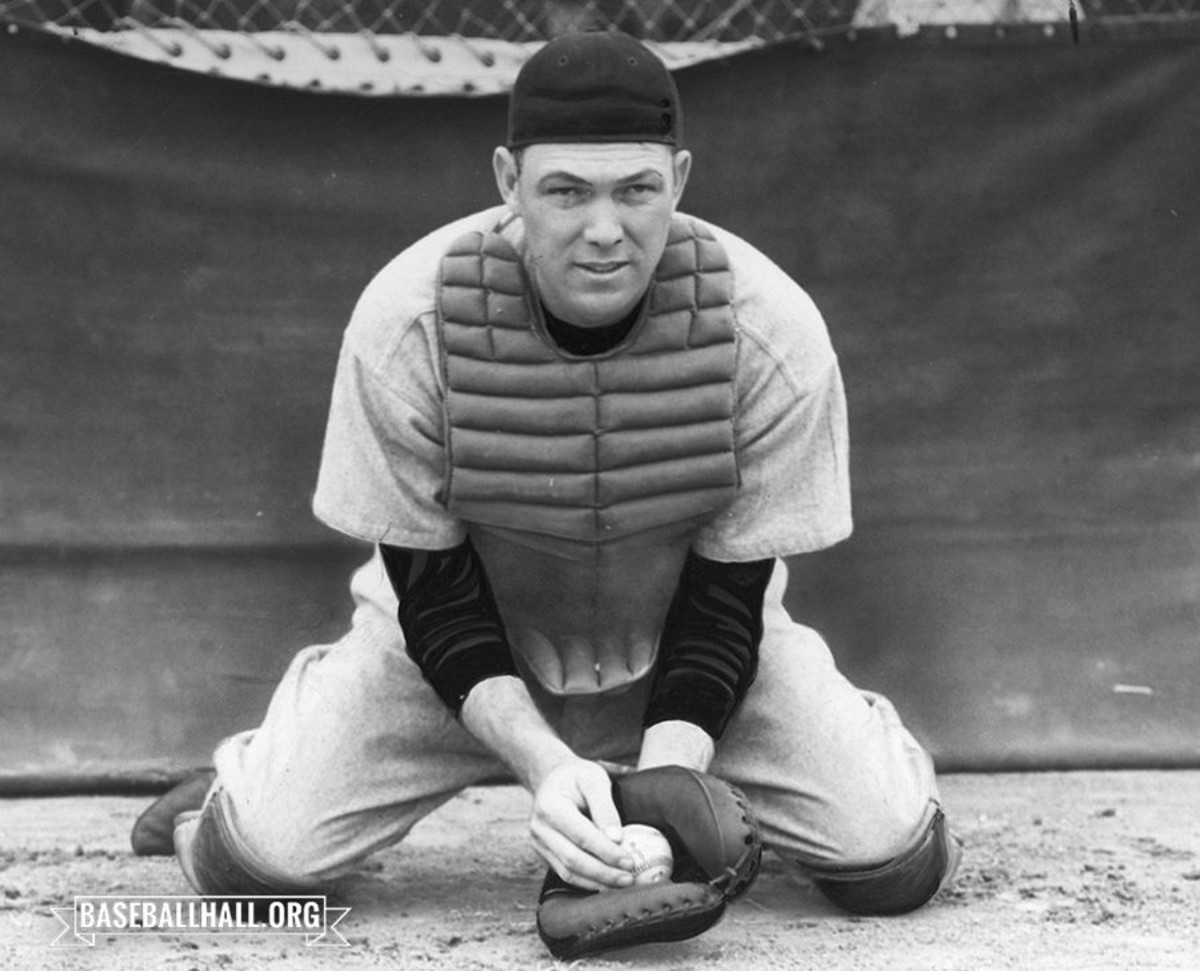
One of the greatest catchers in MLB history, Bill Dickey combined elite hitting, defense, pitch calling, and durability throughout 17 glorious seasons with the Bronx Bombers.
After a 10-game cup-of-coffee in 1928, Dickey became the Yankees’ starting catcher; despite lacking plate discipline (just 14 walks), he hit .324 with 30 doubles and 10 home runs as a rookie and wouldn’t look back.
Regarding his hitting prowess, very few catchers, if any, rivaled Dickey’s production at the plate during the early live-ball era; the only one in the same stratosphere as Dickey was Mickey Cochrane. During the 1930s, he hit over .300 every year except for 1935, while he had a slugging percentage over .400 in all but three seasons of his career. He had at least 10 doubles in every season except his last, and reached double figures in home runs each year from 1932 to 1939.
Most notably, Dickey was absurdly difficult to strike out; he struck out only 289 times in his career and in a miniscule 4.1% of his at-bats. While he didn’t walk much early in his career, he significantly improved his discipline in his later years, with walk percentages over 10% in seven of his last eight seasons. Overall, Dickey had a 9.6% career walk rate, and had only three seasons with a strikeout rate higher than 4.3%.
As for his defense, Dickey was both immensely durable and surehanded. He’s the only backstop in American League history to catch at least 100 games in 13 consecutive seasons, a streak that ran from 1929 to 1941. He threw out 47% of attempted base stealers in his career, and in 1931, played in 125 games and didn’t allow a single passed ball. His handling of pitchers was legendary as well; Hall of Fame pitcher Bob Feller once said, “I believe I could have won 35 games if Bill was my catcher.”
While Dickey never won an MVP award, he did have a tremendous peak from 1936 to 1939 that saw him finish in the top six in voting each year, including a second-place finish in 1938. He hit over .300, hit over 20 home runs and had over 100 RBI in each of those seasons, had a wRC+ of 133 or higher each year, and combined for a 22.8 fWAR.
And of course, the Yankees absolutely thrived with Dickey behind the plate. They would play in the World Series eight times during his career (not counting 1928), winning seven of them.
Dickey ultimately concluded his playing career with a .313/.382/.486 slash line, 1,969 hits, 343 doubles, 202 home runs, 1,209 RBI, a 126 wRC+, and 56.1 fWAR. The counting totals could have been even higher if he didn’t miss the 1944 and 1945 seasons to serve in the military (although this likely would have sapped some of his rate statistics, as he was already nearing the end of his career).
With this elite level of play for 17 years, Dickey even has a legitimate argument for the top spot on this list. Ironically, when he became a coach for the Yankees (winning an additional six championships in the process), he would coach and mentor the only catcher in franchise history to surpass him…
#1. Yogi Berra (1946-1963): The Yankee with 10 rings
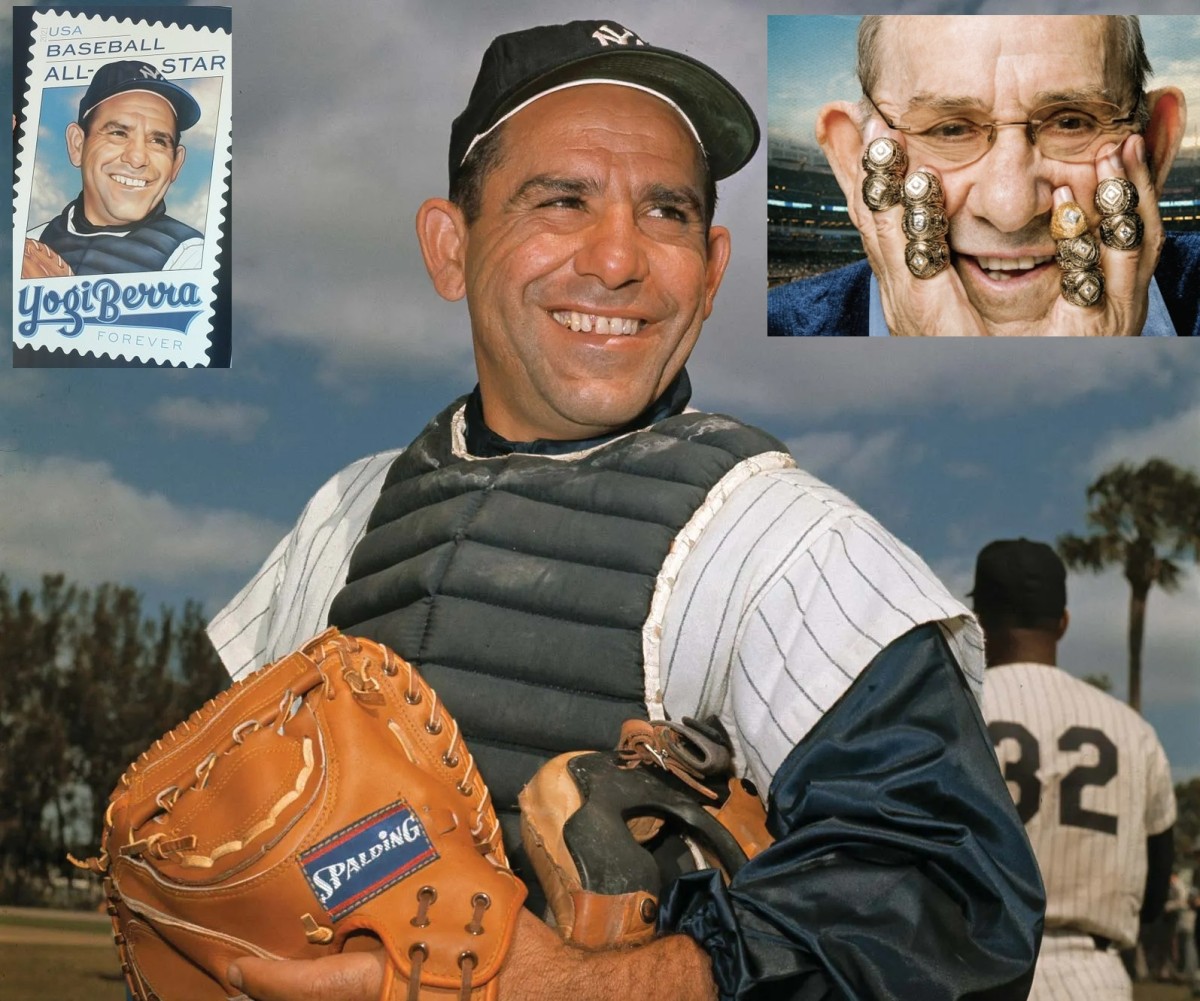
Expecting anyone else to be at the top?
Typically, there are just two catchers regarded as the greatest in MLB history. One of them is Cincinnati Reds legend Johnny Bench; the other, of course, is Lawrence Peter “Yogi” Berra.
Berra was the ultimate dual-threat catcher, with a fantastic power bat, incredible reflexes at and behind the dish, and pitch-calling that has never been matched. All of that led to one championship after another, and a reputation as the greatest winner in the history of the sport.
Let’s start with the offensive stats: Berra had a career slash line of .285/.348/.482 to go with 2,150 hits, 321 doubles, 358 home runs, 1,430 RBI, and a 124 wRC+. Outside of his seven-game cup-of-coffee in 1946 and his final season in 1963, he hit at least 10 homers in every season, and hit at least 20 in ten consecutive seasons (1949-1958). This consistency is complemented by seven seasons (1950-1956) of peak dominance, winning three AL MVP awards and finishing in the top four in the other four seasons, while averaging a .295 clip, 27 home runs, and 108 RBI during that stretch.
Then there’s the strikeout numbers; Berra was near impossible to strike out. Although his career strikeout percentage (4.9%) was higher than Bill Dickey’s, the best way to show Berra’s prowess of avoiding whiffs is the aforementioned seven-year stretch from 1950 to 1956. During this span, he had 4,272 plate appearances and struck out just 166 times. In five of those seasons, he had more home runs than strikeouts. His 1950 season is especially ridiculous; that year, he had a career-high 656 plate appearances… and he struck out just twelve times, for a microscopic 1.8% strikeout rate. Not even Tony Gwynn had a strikeout rate below 2%. Making this even crazier is that Berra hit 28 home runs that season, meaning he had more than twice as many home runs than strikeouts. That’s never happening again.
A major factor in Berra’s ability to avoid strikeouts was his insane plate coverage. He was essentially the Vladimir Guerrero of his era, swinging at everything but making contact with everything. He was capable of hitting line drives on pitches at his head, and could swing the bat like a golf club to hit pitches in the dirt.
As for his defense, Berra would have won plenty of Gold Gloves had it been introduced earlier in his career. He had a 9.2 dWAR across his career, had a 49% caught stealing rate (with a career-best of 58% in 1950), and is one of just four catchers in MLB history to have a perfect fielding percentage in a season, doing so in 1958. He was worth 33 total zone runs above average for his career. Berra had amazing endurance as well; in 1962, his age-37/38 season, he caught an entire 22-inning game that lasted for seven hours.
Finally, Berra’s handling of pitching staff was essentially unrivaled. In 1951, he caught both of Allie Reynolds’ no-hitters, the second of which clinched the American League pennant. In 1956, Berra was, of course, the man who called the pitches for Don Larsen’s perfect game in the World Series; the image of him happily leaping into Larsen’s arms is one of the most famous images in the history of sports. Even disregarding no-hitters or perfect games, pitchers would rarely shake off Berra’s signs; his elite game-calling allowed him to get the most out of every pitcher he caught.
With all of this value that Berra brought to the table, the Yankees won. And won. And won. And won again. During Berra’s playing career, he played in the World Series 14 times, and won 10. That’s a World Series ring for every finger on both hands. In this regard, calling him the baseball equivalent of Bill Russell is very fair (although Russell won 11 championships, one more than Berra).
In the end, Yogi Berra remains one of the most iconic players in the history of baseball and the greatest catcher the Yankees have had in their history, while rivaling Johnny Bench as the best catcher in MLB history. Even with his “Yogi-isms” and status in popular culture, his accomplishments on the diamond should never be overshadowed or understated.
There will never be another Yogi Berra.
Honorable mentions: Three Yankees catcher
Because the Yankees have five catchers who currently have their numbers retired, it makes it very easy to give each of them a top five spot. But what about the ones who aren’t in Monument Park? Here’s where they get some love.
Joe Girardi– Despite being a rather poor hitter, Girardi won three World Series titles with the Yankees, and was the primary catcher for the 1996 team. He caught David Cone’s perfect game in 1999, and his RBI triple in the clinching Game 6 of the 1996 World Series sparked what would be a decisive rally. The stats may not be impressive, but there’s a reason why he was a memorable Yankee even before becoming manager in 2008.
Mike Stanley– Despite being with the Yankees for only five seasons in his 15-year career, Stanley had his greatest success with the Bronx Bombers, with a 12.8 bWAR. Known for his bat instead of his glove, Stanley enjoyed a career year in 1993 by slashing .305/.389/.534 with 26 home runs, a strong performance that netted him a Silver Slugger Award. He was additionally named an All-Star in 1995.
Gary Sanchez– Say what you will about Sanchez’s defense and consistency, but when he was hot at the plate, he was brilliant. He hit 30+ homers in both 2017 and 2019, winning the Silver Slugger in the former year, and had a brilliant rookie season in 2016 (20 homers in just 53 games, and a 170 wRC+) that provided incredible hope for the Yankees’ future. It’s a shame that he didn’t develop into the franchise catcher that he could have been, but the numbers he put up at his best are absolutely worthy of an honorable mention.
What do you think? Leave your comment below.
- Categories: bill dickey, elston howard, jorge posada, thurman munson, Yankees catcher, Yogi Berra
- Tags: bill dickey, elston howard, jorge posada, thurman munson, Yankees catcher, Yogi Berra


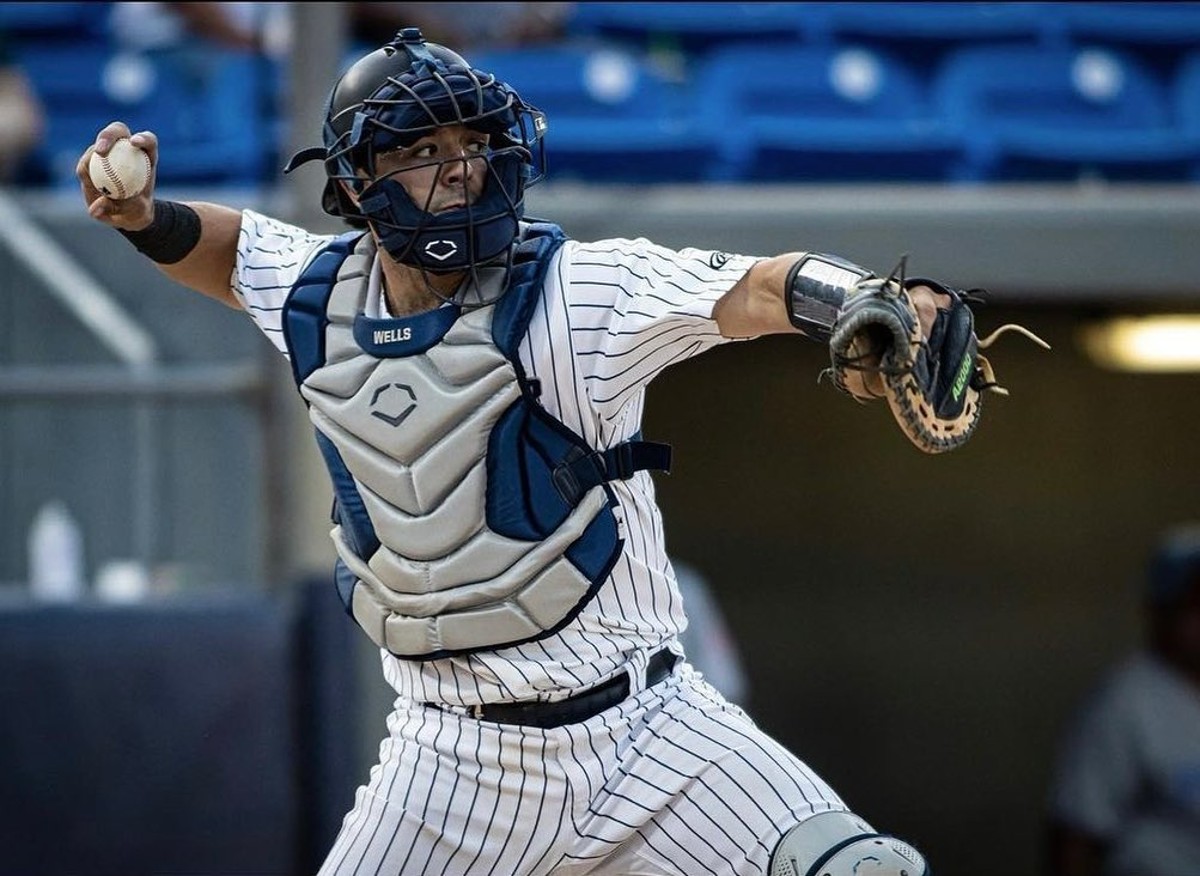
 Follow Us
Follow Us